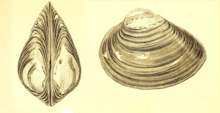Rangia cuneata
Rangia cuneata or Atlantic rangia (also known as wedge clam, gulf wedge clam, common rangia and cocktail clam), is a mollusc native to Gulf of Mexico. It is an oval clam with body length of up to 5cm, living form the interdial zone to depths of 124 meters.[1] It is edible and is harvested for food in Mexico, and has been so since pre-hispanic times.[2]
| Rangia cuneata | |
|---|---|
 | |
| Scientific classification | |
| Kingdom: | Animalia |
| Phylum: | Mollusca |
| Class: | Bivalvia |
| Subclass: | Heterodonta |
| Order: | Venerida |
| Family: | Mactridae |
| Genus: | Rangia |
| Species: | R. cuneata |
| Binomial name | |
| Rangia cuneata G.B. Sowerby I, 1832 | |
Invasive species
Atlantic rangia have been introduced to US North Atlantic coast, Belgium (Antwerp) and Baltic sea.[3]
gollark: Really? I thought I had fixed that.
gollark: Very nice. Is it going to build up a model of its environment as it moves or something?
gollark: As planned.
gollark: Nanomachines are OC hardware, so they can receive OC messages.
gollark: I would not.
References
- "Rangia cuneata". SeaLifeBase. Retrieved 2020-01-24.
- "Rangia and Marsh Clams, Rangia cuneata, R. flexuosa, and Polymesoda caroliniana, in Eastern México: Distribution, Biology and Ecology, and Historical Fisheries". Retrieved 2020-01-24.
- "Rangia cuneata". National Exotic Marine and Estuarine Species Information System. Retrieved 2020-01-24.
This article is issued from Wikipedia. The text is licensed under Creative Commons - Attribution - Sharealike. Additional terms may apply for the media files.